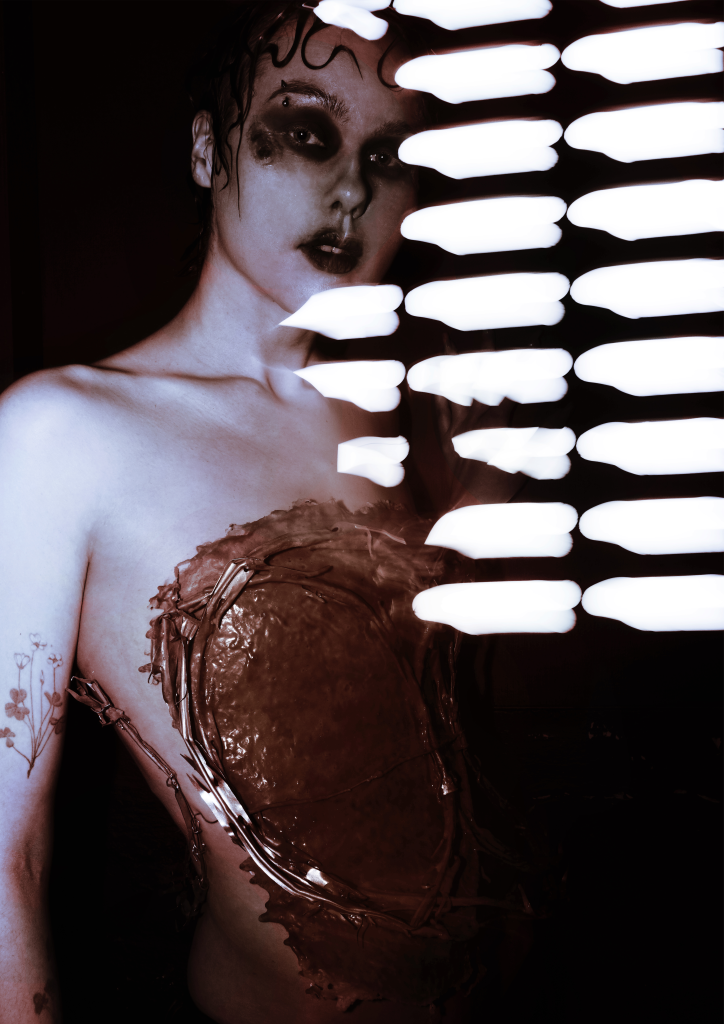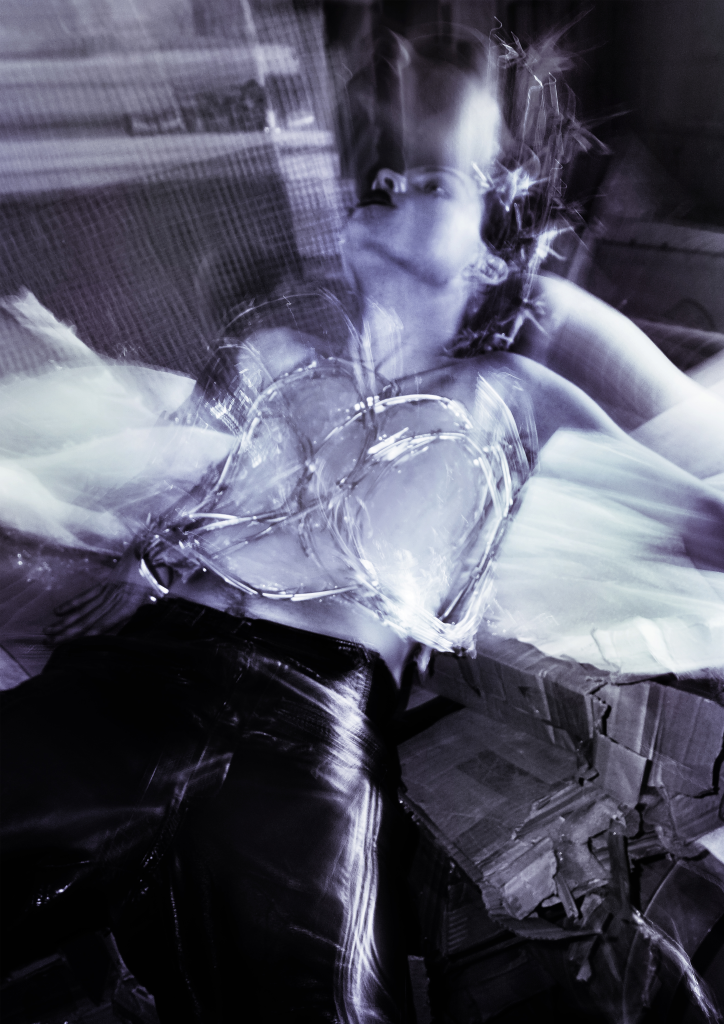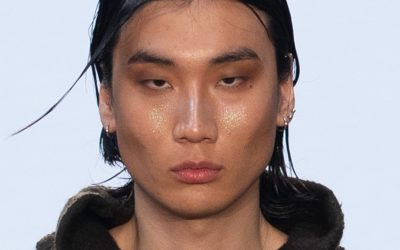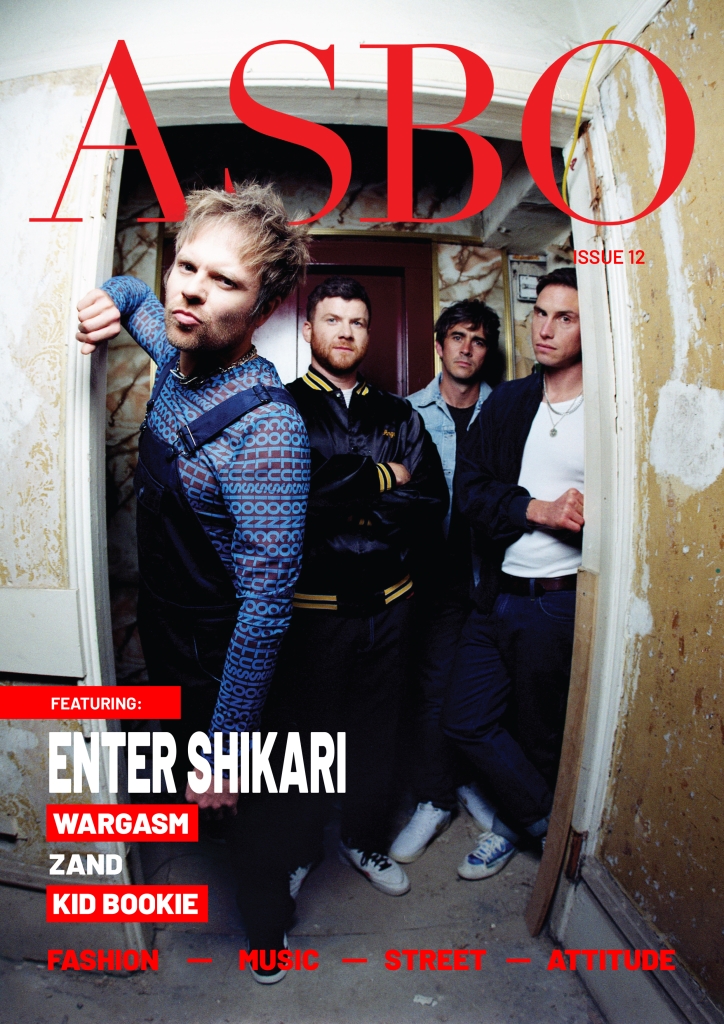
Only one year ago, emerging artist Vesper Alexander (@vesper4__) relocated from Finland to London, and more recently into the kaleidoscope of sensory triggers that is Brick Lane. Here in the city of smoke, sighs and converted churches, they have managed to find a community within the ‘queer techno scene,’ and also at Central Saint Martins. Their art practice transcends and defies gender stereotypes and conventions, locating itself in an area between deconstructed fashion and sculpture. As they passionately tell me, every piece ‘is meant to be worn’.
I first met Vesper at a common friend’s zine launch, on a very hot day of summer.
I was looking around for familiar faces when I finally spotted a couple of old friends. They were talking to someone. A tall figure, sporting a pair of yellow sunglasses. I joined the conversation, then Vesper and I got introduced to each other. ‘My work is featured in the zine,’ they explained. Intrigued by their effortlessly unique style – their very own take on the subversive basics trend, infused with a desire for deconstruction à la Ann Demeulemeester – I excitedly flipped through the pages. I was curious to see what their extravagant mind could concoct, and eager to get to know them through their art.
An armour corset made of glassy silicone and metal immediately caught my eye. Perhaps as a consequence of having spent my teenage years playing Skyrim, my mind then conjured up the image of a Nordic warrior queen, standing on top of a glacier, dominating over an unforgiving land of ice. I will have a chance to tell them this the next time we see each other, adding that in my mind it was a much less Frozen-esque image.
A few months later, in fact, I meet them again outside a small cafe in East London – the area where, coincidentally, we both happen to live. This time I have a very precise goal: to dissect their creative process and find out if they too see mountains and warrior queens while working with different materials, turning them into wearable sculptures. Vesper radiates the same vibrant energy, carrying themselves with a calm, reassuring confidence. I feel at ease around them, and eager to hear everything that they’re willing to share with me.
We sit opposite each other, melodic Middle Eastern tunes blasting through the speakers. They compliment my second-hand Vivienne Westwood bag, and I compliment their top. ‘Jean-Paul Gaultier,’ they say, smiling. We start chatting, and the interview quickly turns into an informal occasion to catch up and share bits of fashion trivia. ‘Did you know Martin Margiela was once Gaultier’s assistant?’ I tell them, for instance, then I start talking about the Belgian designer like we’re best pals. I catch myself doing that and I laugh. Vesper laughs too, ‘In a way,’ they say, shrugging, ‘we do become friends with the designers we love.’ They’re right, I think. You might feel you have achieved a certain form of intimacy with someone, after having worn the tangible products of their imagination. I ask Vesper if that’s one of the reasons why they decided to marry sculpture with fashion, and how they got to where they are now.
‘I have always been interested in garments,’ they tell me, ‘I used to draw a lot, and with time I realised that garments were always part of my drawings. Then when I started the MAFA at Central Saint Martins, I was able to experiment with sculpture. I think that all the classes and workshops unlocked something. I realised I was able to work with different materials, and then I had this idea of body armour. So it’s been a very long process to get to this point.’
They excitedly explain to me how within Fine Arts they have been able to experiment with different art forms, without feeling constricted by any of the conventions of Fashion Design, for instance. ‘I feel like I’m in the right place now for sure, and I have this freedom to explore both worlds. Also because I like working with installations and thinking about how I present my pieces, which I have been able to do by studying Fine Arts.’

Angel Armour is the name of the piece that initially caught my eye, the corset made of silicone and metal. ‘When you first start working on something like this, how do you turn an abstract idea into an actual, tangible piece?’ I ask. ‘Trial and error, for sure. When I started working on the Angel Armour, for instance, I had to figure out the right ratio of silicone needed. I’ve also worked with latex, but now I really like silicone. It’s very malleable, much easier to mould. Also, once I figure out all the quantities, etc, the making process itself is pretty fast. Although, because silicone sets very quickly, you also have to make sure it doesn’t drip. So that’s quite an intense moment.’
I recall seeing some photos of that piece, displayed at different times and in different contexts on Vesper’s Instagram page. Considering the nature of their work, as wearable art, I am curious to know where they would rather see their pieces – worn by models in fashion editorials, or exhibited in art galleries? They have no doubts. ‘Editorials, for sure. I love seeing them in photoshoots, I love seeing other people’s interpretations of them as well. It’s so exciting for me just to see people wearing them, as opposed to them staying as sculptures that can’t even be touched. Yes, I definitely want them to be worn’. They think about that for a moment, sipping at their vegan drink. ‘Even though they’re not that practical to wear,’ they add, laughing.
When we discuss their main inspirations, a bright-eyed Vesper proclaims their love for ‘anything very dramatic.’ They used to watch runway shows on satellite TV, and quickly fell in love with the spectacle of it all. ‘I was also kind of obsessed with Marie Antoinette for a while and that aesthetic, I just really loved the garments and had this romanticised idea of the whole thing. But then I was also really fascinated by the downfall of the monarchy, the French Revolution, and this purifying force that came with it. Getting rid of the old. I was also really into this anime, growing up…’ My eyes widen. ‘Lady Oscar?’ I ask. ‘Lady Oscar! I think it was the first anime I ever watched, and later on I realised what impact Lady Oscar as a character had had on me, growing up. A girl raised as a boy. That had a big impact on me, for sure.’
This exchange will stay with me for a while. I can see us both, two kids raised in opposite sides of the world, watching the same anime, dreaming similar dreams. Dreaming of foreign countries and future lives we are so eager to live, clothes we are eager to wear and, in Vesper’s case, even create. I feel incredibly privileged to be able to connect with someone through their art, style, slices of childhood mixed with pop culture references.
Delving more deeply into Vesper’s life in Finland, where they grew up on a farm surrounded by a forest, I ask if they’ve incorporated any elements of that culture and world into their work. ‘I think the seasons,’ they reply, ‘those extremes, going from pure light to pure darkness has had an impact on me, and somehow on my senses and how I perceive the world. Other than that…I feel maybe being brought up in rural Finland, watching Lady Oscar and runway shows, made me more creative and imaginative as a kid. But I also think I have been trying to get away from Finnish stuff. I’m not a fan of the minimalism, so I’m trying to explore the other end, the spectacle. I don’t like modesty. It’s too silent there. If there’s something of Finnish culture in my work, I think it comes from my subconscious, but I’m not actively seeking it.’
London has been kind to them, they tell me. They have found their community here and a sense of belonging they had not felt in a long time. They finally feel grounded, but ‘not too grounded’. They don’t want to become too familiar with the city, but they also think that London itself will not let it happen. I nod, smiling. I know exactly what they mean.
‘What’s next?’ I ask, while the waiter takes away our empty cups and glasses. ‘Well, the final graduate show at CSM. I would also like to shoot a short fashion film as part of my final project. Lots of exciting things.’
There’s something beautifully delicate as well as incredibly powerful in Vesper’s wearable art. Softness and fortitude coexisting and informing each other. Malleable materials and hard metals, masculine and feminine, resilience and adaptability. I feel a strong connection to their work, and I wonder how many people will feel it too. I wonder how many people wish to stand on top of a glacier and feel it all. Feel all they are, embracing every single bit and corner of being, without any fear or shame. Feel the fluid nature of their bodies, as if they were made of glassy silicone, with veins of metal running through them.
Words: Benedetta Mancusi












